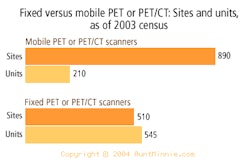Hardware-integrated PET/CT provides greater staging accuracy for non-small cell lung cancer (NSCLC) than either standalone PET imaging or software fusion of PET and CT images from nonintegrated modalities, according to research presented at the RSNA meeting in Chicago last week.
"It has been established that 18F-FDG PET stages NSCLC with high accuracy. Our study sought to determine whether additional gains in diagnostic accuracy arise from integrated PET/CT or software-based PET and CT image fusion," said Dr. Benjamin Halpern of the Ahmanson Biological Imaging Center at the University of California, Los Angeles (UCLA) School of Medicine. Halpern presented the results of his team's research.
The group staged 36 NSCLC patients (17 males and 19 females, mean age 68 years) with an integrated PET/CT system (Reveal RT lutetium oxyorthosilicate PET/CT, Siemens Medical Solutions, Malvern, PA).
"Images were acquired 16 days prior to surgery or mediastinoscopy," Halpern noted. "Separate CT studies were performed on 25 of the 36 patients within six weeks of the integrated PET/CT study."
With these images, image fusion was performed by using commercially available software (Mirada Solutions, Oxford, U.K.). All image fusion conducted by the research team was fully automated, Halpern said.
The final images were interpreted by two nuclear medicine physicians who analyzed in consensus all PET images, and an experienced radiologist was subsequently added to assess integrated and software-fused PET/CT images.
"Histological and pathological findings served as the gold standard for determining the diagnostic accuracy of all the modalities," Halpern said.
The reviewers examined the PET and hardware-integrated PET/CT images, and classified tumor state (T stage) accurately in 67% and 97% of the patients, respectively (p < 0.05), according to Halpern. He noted that PET/CT demonstrated greater accuracy than standalone PET for node staging (N stage), 78% and 69%, respectively.
The interpretations based on standalone PET staged 57% of the patients correctly, overstaged 20%, and understaged the remaining 23%, he reported. The interpretations based on PET/CT correctly staged 83% of the patients, overstaged 10%, and understaged 7%.
The group next analyzed automatic software fusion of separately obtained PET and CT studies, and found that it successfully co-registered images in 68% of the patients.
"In these cases, the results of software fusion with regards to T and N stage were not different from the images obtained with hardware-integrated PET/CT," Halpern said.
However, software fusion failed in 32% of the patients. Halpern noted that the research team used the version of the image reconstruction software available at the time of the study and that the company has since released a new iteration.
"Integrated PET/CT compared with PET alone showed greater diagnostic accuracy and demonstrated greater reliability than software fusion of PET and CT images," Halpern said.
By Jonathan S. Batchelor
AuntMinnie.com staff writer
December 7, 2004
Related Reading
MR, PET/CT show low sensitivity for melanoma, November 30, 2004
FDG-PET offers precise restaging info in recurrent cervical cancer, November 16, 2004
Honing MRI, PET/CT protocols for larger patients, June 30, 2004
LSO PET/CT study wins Image of the Year, June 24, 2003
Copyright © 2004 AuntMinnie.com




















